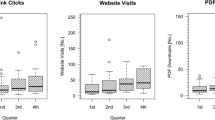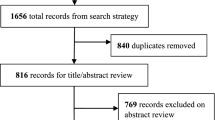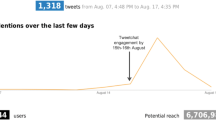Abstract
Background
Twitter journal clubs are a modern way of highlighting articles published in a scientific journal. The Neurocritical Care journal (NCC) initiated a bimonthly, Twitter-based, online journal club in 2015 to increase the outreach of its published articles. We hypothesize that articles included in the Neurocritical Care Society Twitter Journal Club (NCSTJC) had greater engagement than other articles published during the same time period. We also investigated the relationship between number of citations and Altmetric score to assess whether the enhanced online activity resulted in higher citations.
Methods
We gathered data in August 2020 on engagement metrics (number of downloads, Altmetric score, relative citation ratio, and number of citations) of all articles published in NCC between 2015 and 2018. Articles were analyzed into two groups: one featured in NCSTJC and the rest that were not (non-NCSTJC1), and the other comprised those that were not in NCSTJC but published under a similar category of articles as NCSTJC (non-NCSTJC2). Results were analyzed using descriptive statistics, and summary measures were used to report the spread. The groups were compared by using the Wilcoxon rank sum test, given that the data were not normally distributed. Spearman’s rank correlation was used to assess correlation between Altmetric score and citations for the articles in the NCSTJC and non-NCSTJC groups. For comparison, the top ten cited articles in NCC were analyzed for similar correlations.
Results
Between 2015 and 2018, NCC published 529 articles, 24 of which were included in the Twitter journal club. A total of 406 articles were published in the same category as the category of articles selected for NCSTJC. The articles discussed as a part of NCSTJC had a statistically significant trend toward a higher number of downloads, Altmetric score, relative citation ratio, and number of citations than rest of the articles published in the journal during the same time period and the rest of the articles published in same categories. Three NCSTJC articles were among the ten most-cited articles published by NCC between 2015 and 2018. We did not find a correlation between Altmetric scores and number of citations in the NCSTJC or non-NCSTJC1 or non-NCSTJC2 group, but there was a strong correlation between these two variables in high performing articles when the top ten cited articles were analyzed.
Conclusions
Scientific journals are evolving their social media strategies in attempt to increase the outreach of their articles to the medical community. Platforms such as Twitter journal clubs can enhance such engagement. The long-term influence of such strategies on the impact factor of a medical journal and traditional engagement metrics, such as citations, calls for further research.



Similar content being viewed by others
References
Linzer M. The journal club and medical education: over one hundred years of unrecorded history. Postgrad Med J. 1987;63(740):475–8.
Ahmadi N, McKenzie ME, Maclean A, Brown CJ, Mastracci T, McLeod RS. Teaching evidence based medicine to surgery residents-is journal club the best format? A systematic review of the literature. J Surg Educ. 2012;69(1):91–100.
Topf JM, Sparks MA, Phelan PJ, et al. The evolution of the journal club: from Osler to Twitter. Am J Kidney Dis. 2017;69(6):827–36.
Aamctoday GT. Twitter is Trending in Academic Medicine. AAMC. 2017. https://www.aamc.org/news-insights/twitter-trending-academic-medicine. Accessed Dec 2020.
Chang J, Desai N, Gosain A. Correlation between altmetric score and citations in pediatric surgery core journals. J Surg Res. 2019;243:52–8.
Mullins CH, Boyd CJ, Corey BL. Examining the correlation between altmetric score and citations in the general surgery literature. J Surg Res. 2020;248:159–64.
Wijdicks EFM. The journal and social media. Neurocrit Care. 2016;26(1):1–2.
Elmore SA. The Altmetric attention score: what does it mean and why should I care? Toxicol Pathol. 2018;46(3):252–255. https://doi.org/10.1177/0192623318758294.
Bergstralh EJ, Kosanke JL, Jacobsen SJ. Software for optimal matching in observational studies. Epidemiology. 1996;7(3):331–2.
Cosco TD. Medical journals, impact and social media: an ecological study of the Twittersphere. CMAJ. 2015;187(18):1353–7.
O’Kelly F, Nason GJ, Manecksha RP, et al. The effect of social media (#SoMe) on journal impact factor and parental awareness in paediatric urology. J Ped Urol. 2017;13(5):e1-513.e7.
Widmer JR, Mandrekar J, Ward A, et al. Effect of promotion via social media on access of articles in an academic medical journal: a randomized controlled Trial. Acad Med. 2019;94(10):1546–53.
McNamara P, Usher K. Share or perish: social media and the International Journal of Mental Health Nursing. Int J Ment Health Nurs. 2019;28(4):960–70.
Hepatology ZLS, Case Western Reserve U, Austin LC, et al. Longitudinal relationship between social media activity and article citations in the journal Gastrointestinal Endoscopy. Gastrointest Endosc. 2020;90(1):77–83.
Eysenbach G. Can Tweets predict citations? Metrics of social impact based on Twitter and correlation with traditional metrics of scientific impact. J Med Internet Res. 2011;13(4):e123.
Hawkins CM, Makeba H, Kolenic GE, Carlos RC. Social media and peer-reviewed medical journal readership: a randomized prospective controlled trial. J Am Coll Radiol. 2017;14(5):596–602.
Fargen KM, Ducruet AF, Hyer M, et al. Expanding the social media presence of the editor’s report. J Neurointerv Surg. 2017;9(2):215–8.
Hawkins CM, Hillman BJ, Carlos RC, Rawson JV, Haines R, Duszak,. The impact of social media on readership of a peer-reviewed medical journal. J Am Coll Radiol. 2014;11(11):1038–43.
Baan CC, Dor FJMF. The transplantation journal on social media: the @transplantjrnl journey from impact factor to klout score. Transplantation. 2017;101(1):8–10.
Winter JCFD. The relationship between tweets, citations, and article views for PLOS ONE articles. Scientometrics. 2014;102(2):1773–9.
Fox CS, Bonaca MA, Ryan JJ, Massaro JM, Barry K, Loscalzo,. A randomized trial of social media from Circulation. Circulation. 2015;131(1):28–33.
Roberts JR, Perera M, Lawrentschuk N, Romanic D, Papa N, Bolton D. Globalization of continuing professional development by journal clubs via microblogging: a systematic review. J Med Internet Res. 2015;17(4):e103.
Niehaus WN, Silver JK, Katz MS. The PM&R journal implements a social media strategy to disseminate research and track alternative metrics in physical medicine and rehabilitation. PM R. 2018;10(5):538–43.
Nocera AP, Boyd CJ, Boudreau H, Hakim O, Rais-Bahrami S. Examining the correlation between altmetric score and citations in the urology literature. Urology. 2019;134:45–50.
Na M, Beaumont JL, Berman M, et al. Web-based assessment of outcomes after subarachnoid and intracerebral hemorrhage: a new patient centered option for outcomes assessment. Neurocrit Care. 2015. https://doi.org/10.1007/s12028-014-0098-1.
Torbey MT, Bösel J, Rhoney DH, et al. Evidence-based guidelines for the management of large hemispheric infarction: a statement for health care professionals from the Neurocritical Care Society and the German Society for Neuro-intensive Care and Emergency Medicine. Neurocrit Care. 2015;22(1):146–64. https://doi.org/10.1007/s12028-014-0085-6.
Cai X, Robinson J, Muehlschlegel S, et al. Patient preferences and surrogate decision making in neuroscience intensive care units. Neurocrit Care. 2015;23(1):131–41. https://doi.org/10.1007/s12028-015-0149-2.
Rodricks MB, Hawkins SE, Anderson GA, Basignani C, Tuppeny M. Mandatory intensivist management decreases length of stay, facilitates an increase in admissions and minimizes closure of a neurocritical care unit. Neurocrit care. 2015. https://doi.org/10.1007/s12028-015-0148-3.
Olson DM, Stutzman S, Saju C, Wilson M, Zhao W, Aiyagari V. Interrater Reliability of Pupillary Assessments. Neurocrit Care. 2015;24(2):251–7. https://doi.org/10.1007/s12028-015-0182-1.
Claassen J, Riviello JJ, Silbergleit R. emergency neurological life support: status epilepticus. Neurocrit Care. 2015. https://doi.org/10.1007/s12028-015-0172-3.
Fried HI, Nathan BR, Rowe AS, et al. The insertion and management of external ventricular drains: an evidence-based consensus statement: a statement for healthcare professionals from the neurocritical care society. Neurocrit Care. 2016;24(1):61–81. https://doi.org/10.1007/s12028-015-0224-8.
Lamartine Monteiro M, Taccone FS, Depondt C, et al. The prognostic value of 48-h continuous EEG during therapeutic hypothermia after cardiac arrest. Neurocrit Care. 2016. https://doi.org/10.1007/s12028-015-0215-9.
Choi HA, Bajgur SS, et al. quantification of cerebral edema after subarachnoid hemorrhage. Neurocrit Care. 2016. https://doi.org/10.1007/s12028-015-0229-3.
New AM, Nei SD, Kashani KB, Rabinstein AA, Frazee EN. Levetiracetam pharmacokinetics during continuous venovenous hemofiltration and acute liver dysfunction. Neurocrit Care. 2016. https://doi.org/10.1007/s12028-016-0242-1.
Diringer MN, Dhar R, Scalfani M, et al. Effect of high-dose simvastatin on cerebral blood flow and static autoregulation in subarachnoid hemorrhage. Neurocrit Care. 2016;25(1):56–63. https://doi.org/10.1007/s12028-015-0233-7.
Halperin JJ, Moran S, Prasek D, Richards A, Ruggiero C, Maund C. Reducing hospital-acquired infections among the neurologically critically Ill. Neurocrit Care. 2016. https://doi.org/10.1007/s12028-016-0286-2.
Lerner DP, Kim J, Izzy S. Neurocritical care education during residency: opinions (NEURON) study. Neurocrit Care. 2017. https://doi.org/10.1007/s12028-016-0315-1.
Finger JR, Kurczewski LM, Brophy GM. Clevidipine versus nicardipine for acute blood pressure reduction in a neuroscience intensive care population. Neurocrit Care. 2017. https://doi.org/10.1007/s12028-016-0349-4.
Neugebauer H, Schnabl M, Lulé D, Heuschmann PU, Jüttler E. Attitudes of patients and relatives toward disability and treatment in malignant MCA infarction. Neurocrit Care. 2017. https://doi.org/10.1007/s12028-016-0362-7.
Newey CR, Le NM, Ahrens C, Sahota P, Hantus S. The Safety and effectiveness of intravenous lacosamide for refractory status epilepticus in the critically Ill. Neurocrit Care. 2017. https://doi.org/10.1007/s12028-016-0322-2.
Lamartine Monteiro M, Taccone FS, Depondt C, Lamanna I, Gaspard N, Ligot N, Mavroudakis N, Naeije G, Vincent JL, Legros B. The Prognostic value of 48-h continuous EEG during therapeutic hypothermia after cardiac arrest. Neurocrit Care. 2016;24(2):153–62. https://doi.org/10.1007/s12028-015-0215-9 (PMID: 26567031).
Bendella H, Maegele M, Hartmann A, et al. Cerebral ventricular dimensions after decompressive craniectomy: a comparison between bedside sonographic duplex technique and cranial computed tomography. Neurocrit Care. 2017. https://doi.org/10.1007/s12028-016-0359-2.
Quinn T, Moskowitz J, Khan MW, et al. What families need and physicians deliver: contrasting communication preferences between surrogate decision-makers and physicians during outcome prognostication in critically Ill TBI patients. Neurocrit Care. 2017. https://doi.org/10.1007/s12028-017-0427-2.
Nasr DM, Tomasini S, Prasad A, Rabinstein AA. Acute brain diseases as triggers for stress cardiomyopathy: clinical characteristics and outcomes. Neurocrit Care. 2017. https://doi.org/10.1007/s12028-017-0412-9.
Hwang DY, Sheth KN, et al. Factors considered by clinicians when prognosticating intracerebral hemorrhage outcomes. Neurocrit Care. 2017. https://doi.org/10.1007/s12028-017-0430-7.
Saherwala AA, Stutzman SE, Osman M, et al. Correlation of noninvasive blood pressure and invasive intra-arterial blood pressure in patients treated with vasoactive medications in a neurocritical care unit. Neurocrit Care. 2018. https://doi.org/10.1007/s12028-018-0521-0.
Ibrahim AS, Aly MG, et al. Semi-quantitative cough strength score as a predictor for extubation outcome in traumatic brain injury: a prospective observational study. Neurocrit Care. 2018. https://doi.org/10.1007/s12028-018-0539-3.
Moheet AM, Livesay SL, et al. Standards for neurologic critical care units: a statement for healthcare professionals from the neurocritical care society. Neurocrit Care. 2018. https://doi.org/10.1007/s12028-018-0601-1.
Frontera JA, Lewin JJ 3rd, Rabinstein AA, et al. Guideline for reversal of antithrombotics in intracranial hemorrhage: a statement for healthcare professionals from the neurocritical care society and society of critical care medicine. Neurocrit Care. 2016;24(1):6–46. https://doi.org/10.1007/s12028-015-0222-x.
Leitinger M, Höller Y, Kalss G, et al. Epidemiology-based mortality score in status epilepticus (EMSE). Neurocrit Care. 2015;22(2):273–82. https://doi.org/10.1007/s12028-014-0080-y.
Kurland DB, Khaladj-Ghom A, Stokum JA, et al. Complications associated with decompressive craniectomy: a systematic review. Neurocrit Care. 2015;23(2):292–304. https://doi.org/10.1007/s12028-015-0144-7.
Souter MJ, Blissitt PA, Blosser S, et al. Recommendations for the critical care management of devastating brain injury: prognostication, psychosocial, and ethical management: a position statement for healthcare professionals from the neurocritical care society. Neurocrit Care. 2015;23(1):4–13. https://doi.org/10.1007/s12028-015-0137-6.
Nyquist P, Bautista C, Jichici D, et al. Prophylaxis of venous thrombosis in neurocritical care patients: an evidence-based guideline: a statement for healthcare professionals from the neurocritical care society. Neurocrit Care. 2016;24(1):47–60. https://doi.org/10.1007/s12028-015-0221-y.
Cardim D, Robba C, Bohdanowicz M, et al. Non-invasive monitoring of intracranial pressure using transcranial doppler ultrasonography: is it possible? Neurocrit Care. 2016;25(3):473–91. https://doi.org/10.1007/s12028-016-0258-6.
Dias C, Silva MJ, Pereira E, et al. Optimal cerebral perfusion pressure management at bedside: a single-center pilot study. Neurocrit Care. 2015;23(1):92–102. https://doi.org/10.1007/s12028-014-0103-8.
Madden LK, Hill M, May TL, et al. The implementation of targeted temperature management: an evidence-based guideline from the neurocritical care society. Neurocrit Care. 2017;27(3):468–87. https://doi.org/10.1007/s12028-017-0469-5
Acknowledgements
We would like to acknowledge the statistical assistance of the Wake Forest Clinical and Translational Science Institute, which is supported by the National Center for Advancing Translational Sciences, National Institutes of Health, through Grant Award Number UL1TR001420.
Funding
No funding source was reported.
Author information
Authors and Affiliations
Contributions
AS made substantial contributions to conception and design, acquisition of data, or analysis and interpretation of data. She contributed to drafting the article and revising it critically for important intellectual content. MD contributed to drafting the article and revising it critically for important intellectual content. PJ contributed to drafting the article and revising it critically for important intellectual content. JKE made substantial contributions to data analysis. AK Jha was the chair of the Communication Committee, Neurocritical Care Society, at the initiation of Neurocritical Care Society Twitter Journal Club. EW contributed to drafting the article and revising it critically for important intellectual content. The final manuscript was approved by all authors.
Corresponding author
Ethics declarations
Conflict of interest
Aarti Sarwal is the Social Media Editor of Critical Care Medicine and Neurocritical Care. Masoom Desai is the Social Media Ambassador for the Neurocritical care journal. Abhay Kumar Jha was the chair of the Communication Committee, Neurocritical Care Society, at the initiation of Neurocritical Care Society Twitter Journal Club. Eelco Wijdicks is the founding Editor-in-Chief of the Neurocritical Care Journal. The remaining authors have no conflicts to disclose.
Ethical approval
This article does not contain any studies with human participants or animals performed by any of the authors. We followed adherence to ethical guidelines.
Additional information
Publisher's Note
Springer Nature remains neutral with regard to jurisdictional claims in published maps and institutional affiliations.
Supplementary Information
Below is the link to the electronic supplementary material.
Rights and permissions
About this article
Cite this article
Sarwal, A., Desai, M., Juneja, P. et al. Twitter Journal Club Impact on Engagement Metrics of the Neurocritical Care Journal. Neurocrit Care 37, 129–139 (2022). https://doi.org/10.1007/s12028-022-01458-7
Received:
Accepted:
Published:
Issue Date:
DOI: https://doi.org/10.1007/s12028-022-01458-7




